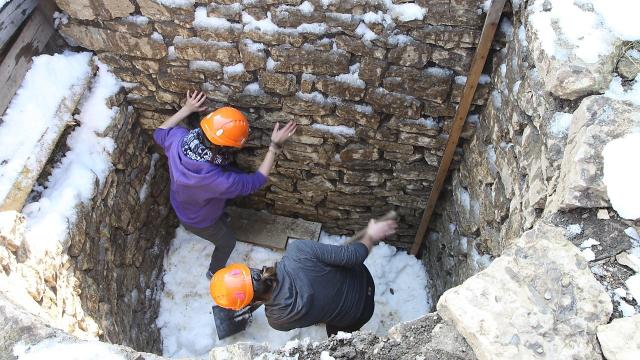Archaeologists working in a shaft at Augusta Raurica.Photo: Peter-Andrew Schwarz/University of Basel
Archaeologists in Switzerland are conducting an experiment to figure out how ancient Romans used a series of deep shafts to keep food cool well into the summer months.
The shafts were discovered in 2013 at Augusta Raurica, an archaeological site located near the Swiss city of Basel. The Roman colony was founded in 15 BC, and it soon blossomed into a vibrant metropolis and trade hub that was home to around 15,000 to 20,000 people. But by 300 AD, an unfortunate mixture of war, epidemics, and crop failures meant that most of the city had to be abandoned. Today, Augusta Raurica remains one of the best-preserved Roman cities north of the Swiss Alps.
At other locations, Romans used similar shafts to store fruit, vegetables, oysters, cheese, wine, and other perishable goods. The shafts were prepared during the winter months, a time when the Romans filled them with snow, ice, and a cover of straw. But the exact method, like so many other techniques lost to history, isn’t entirely known.
As reported in The Local, a research team led by Peter-Andrew Schwarz from the University of Basel is now trying to determine if the Romans used the meter deep shafts in Augusta Raurica as an ancient form of refrigeration, and to figure out how they did it. Schwarz’s team is engaging in some experimental archaeology, in which they will attempt to do as the Romans did.
Actually, this is the team’s third attempt. The first time they tried to do this the researchers filled the shafts with snow and ice all in one go, but the technique proved ineffective; temperatures inside rose to above the freezing point – even during the winter months. The second attempt proved more successful, whereby the researchers gradually filled the shafts with ice and snow. With this technique, the snow managed to hang around until June. Not bad.
But this time around the team is recruiting a bit of help to see if they can make the cooling effect last even longer. Inspired by ice-makers, or nevaters, from the Spanish island of Majorca, the researchers are going to lay down 20 to 30cm layers of snow, and then compact each layer with a cover of straw. The nevaters of Majorca used a similar technique to keep food cool during the summer months before the advent of electric refrigeration, so it’s a good lead.
Schwarz’s team will be putting down the layers this week, and they will evaluate their efforts in August. We’ll do a follow up at that time and let you know if it worked.
